Again, men tell us that our preaching should be positive and not negative, that we can preach the truth without attacking error. But if we follow that advice we shall have to close our Bible and desert its teachings. The New Testament is a polemic book almost from beginning to end….It is when men have felt compelled to take a stand against error that they have risen to the really great heights in the celebration of the truth.
—John Gresham Machen—
Key point: During the annual meeting of the Southern Baptist Convention held in Birmingham, Alabama on June 11-12, 2019, the social justice movement strengthened its grip on the SBC. The good news, however, is that the people in the pews still can recognize the problems, rise up, speak out, and demand a return to biblical truth and the gospel. The hour is late, however, and Southern Baptists must act quickly and with firm resolve.
Phillip Johnson, a retired University of California at Berkeley law professor, turned the debate about natural selection on its head in 1991 with the release of his groundbreaking book Darwin on Trial. Writing from a legal perspective, Johnson successfully poked holes in the arguments Darwinists made for their particular perspective on origins. The brilliant professor showed how advocates of natural selection were unfairly framing the debate, cutting off advocates of a theistic theory of the origin of life on earth by saying things like, “Well, that’s religion, and here we deal with science.” Yet the scientific evidence strongly points to the existence of an intelligent being, not merely impersonal forces acting randomly.
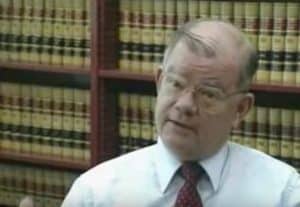
Johnson also showed how Darwinists’ conclusions resulted from their philosophical presuppositions rather than an honest examination the evidence. He declared, “Darwinism is not merely a support for naturalistic philosophy: it is a product of naturalistic philosophy.” He also noted, “[I]t is not that evolutionary naturalists have been less brazen than the scientific creationists in holding science hostage, but rather that they have been infinitely more effective in getting away with it.”
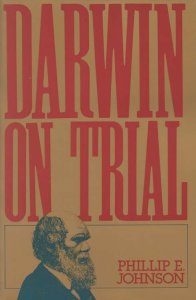 Since Darwin on Trial made its mark on the scientific community and beyond, Darwinists have had a harder time dismissing the scientific arguments of those making the case for an intelligent designer, be He the God of the Bible or some other personal force.
Since Darwin on Trial made its mark on the scientific community and beyond, Darwinists have had a harder time dismissing the scientific arguments of those making the case for an intelligent designer, be He the God of the Bible or some other personal force.
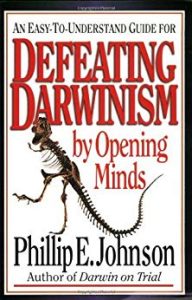 Johnson went on to write several more books, including one titled An Easy-to-Understand Guide for Defeating Darwinism by Opening Minds in 1997. In it, he cites a suggestion made by the late astronomer Carl Sagan. Sagan, Johnson noted, was quite concerned that people were buying into irrational philosophies like astrology and the notion that aliens arrive on earth in flying saucers and abduct people to evaluate and study them. Equally worrisome, according to Sagan, was the reality that people continued to believe that they were created by—you guessed it—God, despite all he had done to convince them otherwise. Sagan suggested that “baloney detector kits” need to be made available so individuals readily can recognize and reject false reasoning. Johnson agreed with Sagan regarding his idea of the need for such kits, or skills—but he astutely applied the idea to the need Christians have to recognize the faulty logic Darwinists use when they contend for the validity of their own naturalistic worldview.1
Johnson went on to write several more books, including one titled An Easy-to-Understand Guide for Defeating Darwinism by Opening Minds in 1997. In it, he cites a suggestion made by the late astronomer Carl Sagan. Sagan, Johnson noted, was quite concerned that people were buying into irrational philosophies like astrology and the notion that aliens arrive on earth in flying saucers and abduct people to evaluate and study them. Equally worrisome, according to Sagan, was the reality that people continued to believe that they were created by—you guessed it—God, despite all he had done to convince them otherwise. Sagan suggested that “baloney detector kits” need to be made available so individuals readily can recognize and reject false reasoning. Johnson agreed with Sagan regarding his idea of the need for such kits, or skills—but he astutely applied the idea to the need Christians have to recognize the faulty logic Darwinists use when they contend for the validity of their own naturalistic worldview.1
Social Justice Ideologies on Trial
Borrowing from both Sagan and Johnson, I would like to suggest that Southern Baptists need their own “baloney detector kits.” This especially was evident recently at the Southern Baptist Convention in Birmingham, Alabama during the discussion and debate over Resolution 9—On Critical Race Theory and Intersectionality. Go here for the complete text of the resolution. We will refer to various clauses in the resolution as they have been designated here (with W referring to a “whereas” clause, and R referring to a “resolved” clause).
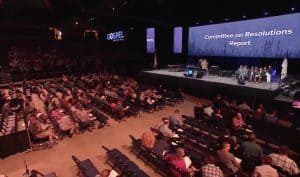
Please know that in making the observations I’m about to make, I mean no disrespect to the Resolutions Committee or its members. Neither my concerns nor my criticisms are personal. I am not saying they or other SBC leaders are not my brothers and sisters in Christ. Yet I am compelled to point out baloney when I see it. For our purposes here, the term baloney refers to information and ideas that are misleading or false, and therefore potentially or presently dangerous. I am assuming that Resolutions Committee members acted with good intentions, but good intentions on their part will not negate the damage Resolution 9 will cause. This makes shining the spotlight on the resolution’s problems all the more urgent. Dr. Phillip Johnson put Darwinism on trial; it is high time we put the ideologies of the social justice movement on trial as well. Fasten your seat belts! We have a lot to cover!
Dr. Phillip Johnson put Darwinism on trial; it is high time we put the ideologies of the social justice movement on trial as well.
Religious Components of the Social Justice Movement
As you read, keep in mind not only our definition of baloney, but the following additional definitions as well.
- The term woke refers to a component within the social justice movement that stresses the importance being keenly aware of and sensitive to what is believed to be society’s systemic oppression of blacks and other minorities. Who, or what, is responsible for this oppression? Whites, whiteness, and/or white supremacy, of course!2 Whites are “woke” if they are mindful of this oppression and if they’re willing to take responsibility for it, including engaging in efforts to correct it in society and in the church. Whites must repent of the sins of slavery, lynchings, and other similar actions, whether or not they themselves were the actual, hands-on perpetrators. The “remedies” that are demanded typically include government redistribution of wealth—from groups who have been “privileged” to groups who have been “oppressed.” Similarly, blacks are woke when they are wise to the “fact” that they and their people have been held back, and when they’re willing to push hard for corrective measures in society and in the church. Finally, churches are woke when they put the themes of white supremacy and its oppression of minorities front and center. Often the woke narrative is introduced in a predominantly white church with the question, Why are our churches so white? The woke answer is that whites are guilty of racism and oppression, not just as individuals, but as a group. Local demographics and the freedom people of all races have to attend the churches of their choice usually are not even considered. Significantly, wokeness has been called “the religion of progressivism.”
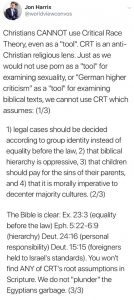 Related to the woke movement are the two ideologies Resolution 9 focuses on, critical race theory and intersectionality. Critical race theory is rooted in Cultural Marxism. Karl Marx viewed society as the working class pitted against the elites. He said that eventually and inevitably, working classes would overthrow elites everywhere. When observers waiting for this to happen widely didn’t see it happen, they began to ask why. Leftist European intellectuals reasoned that Marxism doesn’t have just an economic application, but a cultural application as well, one they needed to utilize. Their movement, which took place mainly between the two World Wars, was known as the Frankfort School. It “sought (among many other things) to apply the ideas of Marx in a social context. What developed from this school was Critical Theory [CT], which is ultimately a re-envisioning of the way the world is seen.” Critical Race Theory [CRT], an ideology that emphasizes various ways racial groups pit themselves against one another, emerged from CT. Both CT and CRT stress the importance of groups rather than individuals in the social structure.
Related to the woke movement are the two ideologies Resolution 9 focuses on, critical race theory and intersectionality. Critical race theory is rooted in Cultural Marxism. Karl Marx viewed society as the working class pitted against the elites. He said that eventually and inevitably, working classes would overthrow elites everywhere. When observers waiting for this to happen widely didn’t see it happen, they began to ask why. Leftist European intellectuals reasoned that Marxism doesn’t have just an economic application, but a cultural application as well, one they needed to utilize. Their movement, which took place mainly between the two World Wars, was known as the Frankfort School. It “sought (among many other things) to apply the ideas of Marx in a social context. What developed from this school was Critical Theory [CT], which is ultimately a re-envisioning of the way the world is seen.” Critical Race Theory [CRT], an ideology that emphasizes various ways racial groups pit themselves against one another, emerged from CT. Both CT and CRT stress the importance of groups rather than individuals in the social structure.- Critical race theory, along with wokeness and intersectionality—all three of these—strongly push the narrative that society is infused white supremacy, white privilege, and systemic oppression against minorities, especially blacks. The oppression and the oppressors, adherents to these movements say, need to be overthrown by empowering those who have been held back. Who, pray tell, are the people who’ve been held back? Minorities, women, homosexuals, and other groups with members who don’t fit the stereotype of those who’ve enjoyed the greatest privilege—straight, white males. Enter intersectionality, which declares that if you’re a woman you’re oppressed; that if you’re a black woman you’re really oppressed; and that if you’re a black lesbian woman you are really, really oppressed! The more of these marginalized groups you’re part of, the more abused and mistreated you are, and the more empowered you need to become to throw off the shackles that have kept you trapped and imprisoned.
These ideologies represent ways members of the social justice movement really view society around them and the world at large—and many of them act and live according to the principles we’ve just cited. In other words, social justice, which includes the ideologies of wokeness, critical race theory, and intersectionality, is a religion; and it’s a religion that is antithetical3 to Christianity and biblical teaching.4
Social justice, which includes the ideologies of wokeness, critical race theory, and intersectionality, is a religion; and it’s a religion that is antithetical to Christianity and biblical teaching.
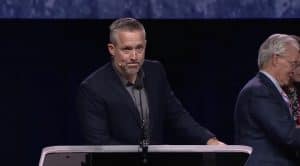
The Convention Adopted Resolution 9, but You Still Can Turn on Your Baloney Detector
Several items in the resolution itself should have set off an individual’s baloney detector, or at least raised some yellow flags, assuming that he or she had it turned on and pointed in the right direction. The good news is that even though Resolution 9 passed, we still can see the baloney for what it really is.
First, the resolution begins with this statement. “WHEREAS, Concerns have been raised by some evangelicals over the use of frameworks such as critical race theory [CRT] and intersectionality [INT]… [W-01].” What concerns? The fact that the resolution begins with this acknowledgement should be a warning to us.
Second, Resolution 9 goes on to acknowledge that “Critical race theory and intersectionality have been appropriated by individuals with worldviews that are contrary to the Christian faith, resulting in ideologies and methods that contradict Scripture… [W-03, emphases added].” Yet, despite these admissions, the resolution calls CRT and INT “analytical tools [that] can aid in evaluating a variety of human experiences” [W-07] and warns that “critical race theory and intersectionality should only be employed as analytical tools subordinate to Scripture—not as transcendent ideological frameworks…” [R-02]. These statements imply that CRT and INT are at odds with Scripture, or at least that they easily can mislead people away from Scripture unless one is very, very careful. We’ve seen in the definitions above that these two systems (as well as wokeness) do indeed contradict biblical teachings. Your baloney detector should be going off here! How can ideas that can be so easily easily misused and that, even according to the resolution itself, are at least potentially in conflict with God’s Word, be effectively tapped as tools to advance God’s kingdom? Such an idea flies in the face of common sense!
Third, CRT and INT were not defined but given descriptions that sought to put them in the best possible light. We see this in W-02: “Critical race theory is a set of analytical tools that explain how race has and continues to function in society, and intersectionality is the study of how different personal characteristics overlap and inform one’s experience.” What?!? Messengers should have been demanding that committee members thoroughly explain what these ideologies are. Having read the definitions above, you know they’re not as harmless as W-02 makes them sound. Early in the discussion on Resolution 9 on the floor, Pastor Tom Buck would step to the microphone, define the terms to the extent that he could, and thereby speak against the resolution (we will highlight his brief speech momentarily); but messengers with their baloney detectors turned on would have to wonder if the committee, through the words of the resolution itself, was either condemning CRT and INT with faint praise or attempting to hide something. Maybe it was doing both, albeit unintentionally.
Fourth, W-07 states that “Critical race theory and intersectionality alone are insufficient to diagnose and redress the root causes of the social ills that they identify, which result from sin.” Pastor Josh Buice rightly asks,
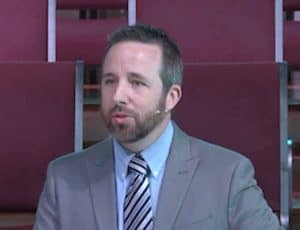
If CRT and intersectionality are insufficient alone to diagnose social ills, what about the Scriptures—are they insufficient alone to diagnose social ills? In a day where we’ve already watched the evangelical world attach woke to church—now the SBC has attached woke to the Scriptures.
The implication of the resolution is that, indeed, God’s Word is insufficient to diagnose social ills! W-07 continues, declaring that despite their insufficiencies, “these analytical tools can aid in evaluating a variety of human experiences.” Let me ask you, given the above definitions, What kinds of evaluations will CRT and INT produce, and how thoroughly will those assessments align with biblical teaching? We might wonder about specifics, but we do not have to wonder at all about the general direction.
Fifth, if CRT and INT are such great tools, then why is it necessary to pass a resolution affirming them? Ahhh! The reason the committee gave is the potential danger of misusing these “tools” by not subordinating them to Scripture. But doesn’t this imply that they are inherently in conflict with Scripture? And if they are that, then why use them in the first place?
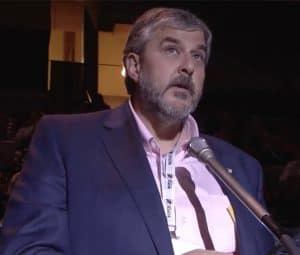
Sixth, Pastor Tom Buck’s speech to the convention in opposition to Resolution 9, heard alongside Dr. Curtis Woods’s response, should have caused messengers to at least feel uneasy about the resolution. The statements from these two men even should have caused messengers en masse to reject the resolution outright. Why take a chance? You can read and hear Dr. Buck’s statement here, along with Dr. Woods’s response. For your convenience, I’m making both of these available as one clip below.
Dr. Buck warned that contrary to W-03, which states that “Critical race theory and intersectionality have been appropriated by individuals with worldviews that are contrary to the Christian faith,” these philosophies “weren’t merely appropriated, but originated with those who would hold unbiblical worldviews.” Moreover, Pastor Buck cautioned that even though W-07 “states that ‘Critical race theory and intersectionality alone are insufficient to diagnose and redress the root causes of the social ills that they identify,'” insufficient isn’t the right word: “They’re not merely insufficient; they’re incapable of diagnosing man’s problem and incompatible with the biblical gospel.”
Then Tom Buck declared forthrightly,
Critical Race Theory is based upon Marxism—a godless intellectual foundation, and both include a praxis contradictory to the gospel of Jesus Christ. These views do not complement the gospel; they completely contradict it. Paul wrote in Colossians 2:6-8, “As you received Christ Jesus the Lord, so walk in Him, rooted and built up and established in your faith, just as you were taught, abounding in thanksgiving. See to it that no one takes you captive by philosophy and empty deceit, according to human tradition.”
Given that CRT and INT contradict Scripture, Dr. Buck rightly used Colossians 2:6-8 to refute them and to warn messengers not to affirm them, even if the affirmation also carried a requirement that they must be subordinate to biblical teachings. There’s the point. Subordinating CRT and INT to biblical teachings has to mean rejecting them outright!
Subordinating CRT and INT to biblical teachings has to mean rejecting them outright!
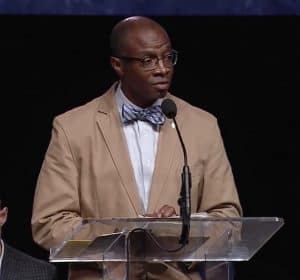
Remarkably and almost bewilderingly, Dr. Curtis Woods, chairman of the Resolutions committee, used the very same passage to argue for passage of the resolution. With due respect to Dr. Woods, this makes no sense—unless one believes that placing ideologies contrary to Scripture under Scriptural authority can make them useful. Instead, it ought to eliminate them from consideration. It is noteworthy that Dr. Woods did not try to refute any of the ways Pastor Buck characterized critical race theory.
Do not misunderstand. It isn’t baloney to uphold Scripture as the supreme authority by which we as believers are to interpret all of life. It is baloney to pretend that using a godless ideology will help bring an inquirer to godly conclusions. Later, in his response to Pastor Tom Ascol, Dr. Woods would emphasize that CRT and INT are tools that are to be used as tools, not as a worldview. Danger ahead! Treating a worldview as a tool actually elevates the authority of that worldview, making it at minimum more authoritative than it ought to be and even leaving the door open for it to be treated as being on par with Scripture. Respectfully, I believe Dr. Woods is being naïve when he says, at the end of his response, that “this resolution stands strong to teach individuals how to engage the culture, keeping the gospel above all.” It is much more likely that individuals using CRT and INT will be taken in by these philosophies. We won’t be able to say that we weren’t warned by either Paul or by Dr. Buck, who echoed the apostle.
It isn’t baloney to elevate Scripture as the supreme authority by which we as believers are to interpret all of life. It is baloney to pretend that using a godless ideology will help bring an inquirer to godly conclusions.
Seventh, Dr. Tom Ascol’s attempt to amend the resolution and the response of the committee raise serious questions. Hear and read Dr. Ascol’s statement here, or listen to the entire exchange below.
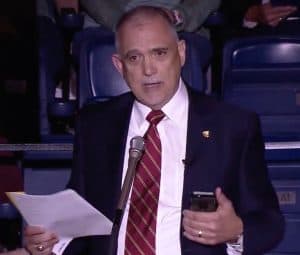
The elements Tom Ascol recommended the Convention add to Resolution 9 included one “whereas” and two “resolveds.” He offered these “to add strength to this resolution—mak[ing] it clearer and more explicitly theological by offering what I hope will be taken as a friendly amendment.” The clauses were as follows, and they’re entirely consistent with the definitions we have cited.
WHEREAS, Critical race theory and intersectionality are godless ideologies that are indebted to radical feminism and postmodernism and neo-Marxism;
RESOLVED, that we remind Southern Baptists that critical race theory and intersectionality emerge from a secular worldview that is rooted in ideologies that are incompatible with Christianity; and be it further
RESOLVED that we repudiate all forms of identity politics and any ideology that establishes human identity in anything other than the divine creation in the image of God and for all redeemed humanity, our common identity, together eternally united to Christ….
Go here to see what the resolution would have said had the amendments Tom Ascol offered had been accepted.
Speaking for the committee, Dr. Woods declared Dr. Ascol’s recommendation to be an “unfriendly amendment.” Why? According to Dr. Woods, “It is our aspiration in this resolution simply to say [that] critical race theory and intersectionality are simply ana-ly-tic-al tools and are to be used as tools, not as a worldview.” He further said that time constraints precluded a discussion about the origins and implications of CRT. Finally, he cited Paul’s discourse on Mars Hill in Acts 17:22-34 and his quotation of Epimenides in Titus 1:12. Just because Paul quoted secular philosophers doesn’t mean, said Dr. Woods, that he embraced what they believed. Granted. But there’s a huge difference between Paul’s approach and what the committee and Resolution 9 seek to authorize.
Let’s take the time argument first. If the convention didn’t have time to discuss the origins and implications of CRT, then it should have rejected the amendment outright or tabled it for possible reconsideration later. One has a right to wonder of Dr. Woods and the committee were trying to push the resolution through without adequate discussion and debate.
Neither Paul’s quotation from Epimenides in Titus 1:12 nor his citations of Greek poets in Acts 17:22-34 parallel the utilization of godless theories and philosophies to interpret and understand human experiences and relationships. Christians must not fall into the trap of thinking that their evangelistic efforts will be enhanced if they use secular belief systems to understand people or to interpret human relationships.
A Tool Versus a Worldview
The truth is that critical race theory and intersectionality—and you can throw wokeness into the mix as well—are worldviews, or they are components of a larger worldview; and treating them merely as tools essentially is playing with spiritual dynamite.
Here is the difference between a worldview and a tool. A worldview is a lens through which people view and interpret the world around them and draw conclusions about God, life, death, humanity, relationships, and eternity. A worldview is a set of assumptions that guide the individual holding them and direct him or her to conclusions. Worldviews are not neutral. Mark it down! Because they are worldviews or components of a larger worldview, wokeness, critical race theory, and intersectionality also are not neutral.
By contrast, a tool is neutral. As an example, consider the baloney detector, which I have used here but borrowed from Phillip Johnson and ultimately from Carl Sagan. That device is merely a tool that anyone can use. Significantly, the tool’s effectiveness is dependent on the validity of the user’s worldview.
While critical race theory, intersectionality, and wokeness have the traits of a worldview, the baloney detector we have been using is a fine example of a tool.
You can’t use CRT and INT in similar ways, because if you try, these two ideologies, in addition to wokeness, will wind up using, and even devouring, you!
Don’t let it happen!
Epilogue
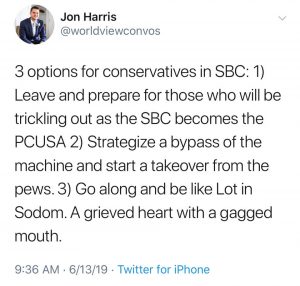 The Southern Baptist Convention is in serious trouble. A day after the annual meeting in Birmingham was over, podcaster Jon Harris of Conversations That Matter tweeted,
The Southern Baptist Convention is in serious trouble. A day after the annual meeting in Birmingham was over, podcaster Jon Harris of Conversations That Matter tweeted,
3 options for conservatives in SBC: 1) Leave and prepare for those who will be trickling out as the SBC becomes the PCUSA 2) Strategize a bypass of the machine and start a takeover from the pews. 3) Go along and be like Lot in Sodom. A grieved heart with a gagged mouth.
I am ruling out the third option completely, and I’m not ready to leave. I am compelled to speak out with the goal of helping people understand the dangers of the direction our denomination is headed and the urgent need to correct its course. This requires all hands on deck! The challenges are formidable.
Why have J. D. Greear and the members of the 2019 SBC Resolutions Committee offered the SBC the cotton candy of social justice rather than authentic spiritual nourishment and a clear, biblical direction? One has to wonder, but understanding the nature and lure of the social justice movement explains a lot.

In his must-read booklet on Social Justice, Calvin Beisner observes,
By appropriating the title “social justice” for their vision, Progressives, who coined the term a century ago, begin with a marked advantage in the debate. Anyone who argues against them can be cast as defending injustice—and who wants to do that?
Critics of Progressive “social justice” have a double task. They must expose and explain the sad and unintended consequences of redistribution. They must also go to the heart of the issue: the meaning of justice itself and whether, in fact, justice requires the sort of equality Progressives claim it does.
Moreover, the influence of the social justice movement in the church is both pervasive and strong. Sad to say, Resolution 9 wasn’t the only resolution coming out of the committee that raised concerns. Resolution 5 originally was written and submitted as a statement against the teachings of the Revoice movement, but the committee took it and gave it a Revoice “flavor.” This, too, sets baloney detectors off. It is totally unacceptable.
And listen to this gem from Dr. Russell Moore! Youth pastor Travis McNeely asked him a simple question during the Ethics and Religious Liberty Commission’s Q&A, and Dr. Moore danced all around it, never once coming close to giving McNeely or any other Southern Baptist an honest answer. Well, come to think of it, in responding the way he did, Dr. Moore let us in on a great deal more than he probably wishes we knew. Go here for more information about this exchange. Go here for AD Robles’s take on Russell Moore’s non-answer.
Thus, regardless of motives, actions that represent departures from God’s Word must be highlighted and challenged. Unfortunately, the shenanigans we’ve highlighted here represent only a tiny fraction of the questionable actions among evangelical leaders in recent months and even years. It’s high time that the people in the pews understood fully what is occurring. The social justice movement is out to destroy the church!
Toward the end that the church might recognize and resist the false teachings being promoted by this movement and by social justice warriors in the church, a group of Christian filmmakers is producing an informative documentary titled Enemies Within the Church. You can find out more information here. Prayerfully consider supporting this effort.
To access additional Word Foundations articles on social justice, go here.
Copyright © 2019 by B. Nathaniel Sullivan. All rights reserved.
Unless otherwise indicated, Scripture passages have been taken from the New King James Version®. Copyright © 1982 by Thomas Nelson, Inc. Used by permission. All rights reserved.
top image: Lightstock
Notes:
1Phillip E Johnson, An Easy-to-Understand Guide for Defeating Darwinism by Opening Minds, (Downers Grove, IL: InterVarsity Press, 1997), 37-38.
2Check out the audio clip of Ekemini Uwan at the Sparrow Conference held earlier this year, in this article.
3Also go here.
4Take, for example, the concept of forgiveness. Christianity teaches that individuals who repent of their sins and receive Christ as their Savior are forgiven and given eternal life and a new nature that seeks to please and honor God through good works (see Eph. 2:8-10). By contrast, the religion of social justice teaches that members of oppressive groups must repent of a host of sins, some of which they themselves may not even be guilty. When repentance occurs, social justice warriors withhold forgiveness and demand retribution. Can unity occur under such a scenario? Can any semblance of racial reconciliation? No, despite the fact social justice warriors claim reconciliation is their goal. What occurs instead? Division, envy, bitterness, resentment, hatred, and victimhood. This is light years away from biblical Christianity!

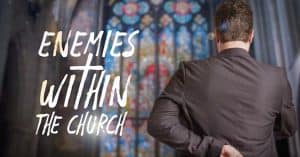
[…] Read the Full Article… […]
[…] we pointed out last time, CRT and INT, as well as wokeness, are social justice, worldview ideologies—not merely […]